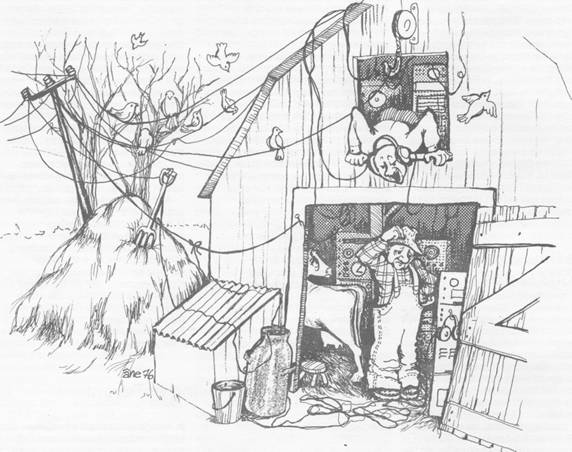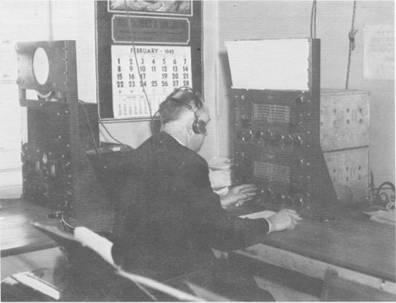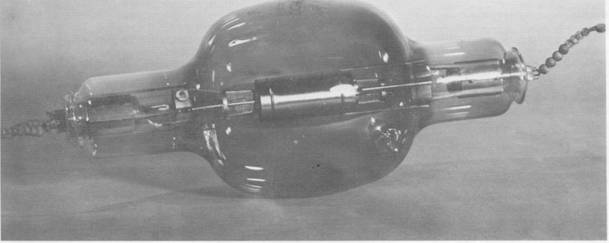|
1976
A monitoring pioneer recalls the way it was
|

How's it coming in now, Hawley ?
|
In the following flashback,
Ed Davey, who retired in
1964 as
manager of the
department's monitoring station at Almonte, recalls setting up that station and
other
highlights from his 40 years in radio
communications. Mr. Davey now lives in
Chatham,
Ontario.
The
Lowry farm near Almonte looked just about right. I'd already
been up the Ottawa Valley as far as Deep
River, testing reception at sites all
the way along Highway 17. I set up
my receiver in Hawley Lowry's milk
barn and slung the sky wires from
the roof peak. I spent the next
three days and nights in the barn
checking out reception.
I
was a little leery that the CPR
main-line tracks might throw a bump into
the accuracy of our direction
finding, but time has proven the site
okay. Twenty years ago last summer the
Almonte Monitoring Station went into
operation. I was manager from
1956 until I retired in 1964.
I
began my career as a radio
operator on the East coast in 1924 when I joined the radio branch of the old
Department of Marine and
Fisheries.
In
1930, I was transferred to Ottawa as
a shortwave operator. About 1927,
surveys had begun for the opening of
navigation through Hudson Strait to Churchill, and the radio branch was
given responsibility for maintaining radio communications from
Ottawa. Shortwave stations were set up
at Port Burwell, Cape Hopes Advance, Nottingham Island,
Chesterfield Inlet and Churchill.
The
receiving station over which
I presided was located in a greenhouse
potting room at the Experimental Farm in Ottawa. The radio
test room had been located at 299
Wellington Street, but there was a lot of
electrical interference in the area. In
those days, a streetcar ran down
Wellington to Hull and its passage
would blot out any signals.
|

Hartlen
Point Monitoring Station,
1942
|
The
director of radio at that time,
Commander
C. P. Edwards, was good
friends with the director of the Experimental Farm, Dr. Edgar Archibald.
As a result of this friendship, the
receiving station found a home in
the country - as
it was then -
far from sources of interference. The
free accommodation was welcome, as
appropriations were hard to come by.
The
original transmitter was a 500watt
Marconi job. As more funds
became available, the Ottawa shortwave station bought a four-kilowatt
transmitter, also supplied by
Marconi. The new transmitter was
installed in space leased from a
wholesale grocery firm on Wellington
Street where the National Library now
stands. The 4 kW Ottawa shortwave
station had the call letters VAA and
transmitted on a frequency of
11,990 kilocycles. When radio
regulations required all transmitters to
be moved out of town, this transmitter
was dismantled and scrapped.
In
late 1936, I was promoted from
radio operator at VAA and given the
job of organizing the Ottawa Monitoring
Station. This was the nucleus of
the present nation-wide monitoring service, set up to monitor all
aspects of radio communications,
both domestic and international, to
ensure that the regulations laid down by the Radio Act of Canada and by the
International Telecommunication
Union (ITU) are respected.
The
war came along, and the
Ottawa Monitoring Station was
engaged, as were a number of other
monitoring stations, in intercepting
enemy communications for the navy.
The
monitoring station at Hartlen
Point, Nova Scotia, was built primarily
for this purpose. It was
operated by the Department of
Transport with close supervision by the
Director of Naval Intelligence. I was
involved with the installation of
equipment at this site. There were two
basic types of equipment: a
high-frequency direction finder
(Adcock type), and an intercepting
station which could pick up and record enemy transmissions. Thus the
station could copy the message and
get a bearing line to its source.
Information from similarly equipped
stations -
some 15 around the North
American coast -
enabled correlating stations in Ottawa and the
United Kingdom to plot the positions of
transmitting U-boats. Naval authorities could then inform commanders
of convoys at sea of these
locations.
For
some years after the war,
Hartlen Point continued as a regular
monitoring station, until it was
decommissioned in 1961. A more
central site for the Maritimes was procured at Montague,
P.E.I., and
a
monitoring station opened there in
1961. The officer in charge of the
Montague station, Robert Ferguson, was
an operator at Hartlen Point during the war.
I
also selected the site for the
monitoring station which opened at
Beaumont, Quebec, in 1954. The
residents of the area had a pretty good
monitoring system of their
own. Every farmer I interviewed between
Lévis
and
Montmagny quoted the same selling price, whether two
acres or 10 were involved. The
amount was exactly what we had in the
appropriation for the purchase of
land, $3,500. In 1966, this station was
moved to St.
Lambert
de
Lévis.

Tube from 4 kW Marconi
transmitter used
by the Ottawa shortwave station
VAA which transmitted on a
frequency of 11990 kilocycles during the
late
1920s and early
1930s to posts
in Hudson Bay and Hudson Strait during the opening of navigation to
Churchill. The 20-inch tube is now in
the collection of the National
Museums of
Canada.
Public Archives photo [PA 105730]

1976
Des souvenirs et
des hommes...
|

Hawley, allume donc mes appareils !
|
Ed Davey, anciennement
gestionnaire
de la station de contrôle
des émissions d'Almonte et à la
retraite depuis 1964, nous rappelle
l'installation de cette station et
évoque d'autres points saillants de
ses 40 années de travail en radio
communication.
M. Davey demeure maintenant à Chatham,
en Ontario.
La ferme Lowry, près d'Almonte,
semblait répondre exactement à mes
besoins. J'avais déjà parcouru la
vallée de l'Outaouais jusqu'à Deep
River, et j'avais vérifié la qualité de la
réception à différents endroits le
long de la route 17. J'installai mon
récepteur dans la laiterie de Hawley
Lowry et plaçai mes fils d'antenne sur le faîte de celle-ci. Je passai les trois
jours suivants et les trois nuits
dans la grange à vérifier la réception.
Je craignais un peu que les voies
ferrées du
CPR
faussent un peu la
précision de notre appareil de radiogoniométrie, mais avec le temps on
a constaté que l'endroit convenait
parfaitement à l'expérience. Il y a eu
vingt ans l'été dernier, que la station
de contrôle des émissions d'Almonte
entrait en exploitation.
J'ai commencé
ma carrière comme opérateur radio sur la côte de l'Atlantique
en 1924, lorsque je suis entré
au service de la direction des radiocommunications
de l'ancien ministère
de la Marine et des Pêcheries.
En 1930, je fus muté à Ottawa
comme opérateur d'ondes courtes.
Vers 1927, des études étaient entreprises
sur l'aménagement d'une voie
navigable depuis le détroit d'Hudson jusqu'à
Churchill,
et la direction des radiocommunications avait été
chargée de maintenir les communications radio provenant d'Ottawa.
Des stations à ondes courtes furent
installées à Port Burwell, à Cape
Hopes
Advance,à l'île
Nottingham,
dans l'anse de
Chesterfield
et à
Churchill.
La station réceptrice dont j'étais responsable était située dans une
serre de la Ferme expérimentale
d'Ottawa. La salle d'essais se trouvait
au 299 de la rue Wellington, mais
il y avait beaucoup de brouillage
électrique dans les environs. A ce moment-là, il y avait un tramway qui descendait la rue Wellington pour se rendre jusqu'à Hull, et son passage brouillait tous les signaux.
|

Station
de contrôle des émissions
de Hartlen
Point,
1942
|
Le directeur des radiocommunications
d'alors, le commandant C. P. Edwards,
était un bon ami du directeur
de la Ferme expérimentale,
M. Edgar Archibald. Grâce à cette
heureuse amitié, la station réceptrice
fut déménagée à la campagne (c'était la campagne alors) loin des
sources de brouillage. Ce logement
gratuit fut fort apprécié, car il était
difficile de se faire allouer des fonds.
L'émetteur original était un appareil
Marconi de 500 W. Ayant obtenu
plus d'argent, la station à ondes courtes d'Ottawa acheta ensuite un
émetteur de 4 kW, également
fabriqué par Marconi. Le nouvel
émetteur fut installé dans un espace
loué d'une compagnie d'épiceries en
gros située sur la rue Wellington, à
l'endroit où se trouve maintenant la
Bibliothèque nationale. La station à
ondes courtes de 4 kW d'Ottawa avait l'indicatif d'appel VAA et émettait
sur une fréquence de 11 990 kHz,
Lorsque le règlement des radiocommunications
exigea que tous les
émetteurs soient déménagés en dehors des limites de la ville, cet
émetteur fut démonté et mis au
rebut.
Vers la fin de 1936, on me chargea
d'organiser la station de contrôle
des émissions d'Ottawa. Ce fut le
point J'origine de l'actuel service
national
de contrôle des émissions,
établi en vue de surveiller tous les
aspects des radiocommunications,
nationales et internationales, pour s'assurer que les règlements établis
par la Loi sur la radio et par l'Union
internationale des télécommunications
(UIT) étaient respectés.
Puis vint la guerre, et la station
de contrôle des émissions d'Ottawa
fut chargée, comme le furent certaines
autres stations de contrôle,
d'intercepter pour la marine les communications
ennemies.
La station de contrôle, située à
Hartlen Point en Nouvelle-Ecosse,
fut construite à cette fin particulière. Elle était exploitée par le ministère
des Transports et surveillée de près
par le directeur des Services navals
de renseignements. Je m'occupai de l'installation du matériel à cet
endroit. Il y avait deux principaux
types de matériel: un appareil de
radiogoniométrie à haute fréquence
(type Adcock), et une station d'interception
qui pouvait capter et
enregistrer les émissions ennemies. La station pouvait ainsi copier le
message et en retracer la source. Les
renseignements obtenus des stations
équipées de façon semblable
(environ 15 sur la côte nordaméricaine)
permirent aux stations
correspondantes d'Ottawa et du
Royaume-Uni de relever la position
des sous-marins allemands. Les
autorités navales pouvaient ainsi
communiquer ces positions aux
commandants des convois en mer.
Pendant quelques années après la guerre, la station de Hartlen Point
fut exploitée comme une station
régulière de contrôle des émissions,
jusqu'à sa fermeture en 1961. Montague
(I.P.-É.)
fournissait un emplacement plus central pour les
Maritimes. On y ouvrit une station
de contrôle en 1961. Le responsable
de la station de Montague, Robert Ferguson, était opérateur radio à Hartlen
Point durant la guerre.
Ce fut également moi qui choisit
l'emplacement de la station de contrôle
des émissions de Beaumont
(Québec), inaugurée en 1954. Les
habitants de la région étaient très
bien informés. Chaque fermier
interrogé entre Lévis et Montmagny
m'a fixé le même prix de vente, que
ce soit pour deux ou dix
acres
de
terre. Le montant correspondait
exactement aux fonds alloués pour
l'achat du terrain, soit $3 500. En 1966, cette station fut déménagée à
Saint-Lambert de Lévis.

Tube d'un
émetteur Marconi d'une
puissance de 4kW, utilisé parla station
à ondes courtes d'Ottawa VAA,
à la fin
des années 20 et au début des
années 30.
La station émettait sur la
fréquence de 11 990
kilocycles
et
maintenait les radiocommunications
avec
des postes de la baie et du détroit
d'Hudson lors de l'ouverture de la navigation à destination de
Churchill
(Manitoba).
Le tube
de 50 cm
fait maintenant
partie de la collection des
Musées
nationaux du
Canada.
Photo des Archives publiques du
Canada (PA 105730)
|

